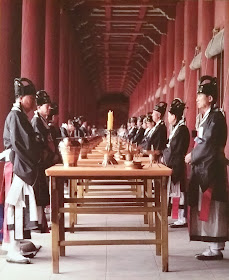Each year on the first Sunday in
May the Royal Ancestral Memorial Rite of the Joseon Dynasty is held at the
Jongmyo, the Royal Ancestral Shrine of the last Kings of Korea. The Yi family
founded the Joseon (Choson) Dynasty in 1392, ruling Korea until 1910 when the
monarchy was deposed by the Japanese colonial administration who ruled Korea
until the end of the Second World War.
First constructed in 1394 the
Jongmyo was built to house the ancestral memorial tablets (Sinju) of the Joseon Royal Family. The building complex has changed
over time, notably when it burned down in 1592 during the Imjin War (1592-1598)
when Korea was first invaded by neighbouring Japan. It was rebuilt in 1608 and
has since been adapted and expanded – for me though it’s one of the old timber
buildings surviving in Seoul which genuinely feels old. Many of the other old
palaces and city gates have been heavily restored and/or wholly reconstructed
in recent years having suffered significant depredations or wholesale
destruction during the recent wars and colonial occupation of the city. There’s
something very serene about this old building and its weathered flagstone
courtyard. I also like its long, low and somewhat understated architecture too.
Surrounded by evergreen trees it has a very real sense of atmosphere, ancient
and revered.
During the five centuries of Joseon
rule the King held ceremonies here five times a year to mark the four seasons
and the winter sacrificial day (nabil).
The Royal Ancestral Rite held in May was discontinued in 1910 under the
Japanese but has since been revived, even though the monarchy itself has not
been restored. However, I believe the ceremony is still superintended by descendants
of the Royal Family. The ceremony, known as the Jongmyo Daeje, was first witnessed by ordinary folk when the “great
rite” (Daeje) was revived in the
1960s. It is a Confucian ritual in which offerings of food and wine are offered
up to the departed spirits of the Royal ancestors. Ceremonial recitations are
made, traditional court music and dances are performed, with everyone taking
part wearing elaborate and colourful traditional courtly costumes. This is the
one day of the year when the doors of the spirit chamber (Sinsil) are opened up. Ordinarily when you visit Jongmyo the doors
are closed and all you can see is the building’s exterior. The spirit chamber
is the place where the mortuary tablets are housed. These tablets are enshrined
in spirit chests (Sinjujang) which
are located at the rear of the spirit chamber with the King’s tablet stored on
the west side and the Queen’s on the east side. The building also contains
various other pieces of ritual paraphernalia, such as book chests, parasols,
fans, chests containing Royal seals, and other ritual utensils, such as plates,
cups, ewers, ladles, and censers. In 1995 UNESCO added Jongmyo and the Royal
Ancestral Rite to its list of protected world heritage sites.
When I visited in 2010 sadly I
missed the Jongmyo Daeje by only a
few days. There is a museum attached to the Jongmyo with two exhibition halls which
explain the function of the building, the spirit tablets and their associated
rituals, as well as the tenets of Confucianism which prescribe and regulate the
manner in which the ancestors should be honoured and remembered. Seeing
photographs of this lavish ceremony though it seems to be a fascinating event
to witness. I hope I get the chance to go back one day and see it for myself.
Also on 'Waymarks'










No comments:
Post a Comment
Comments do not appear immediately as they are read & reviewed to prevent spam.